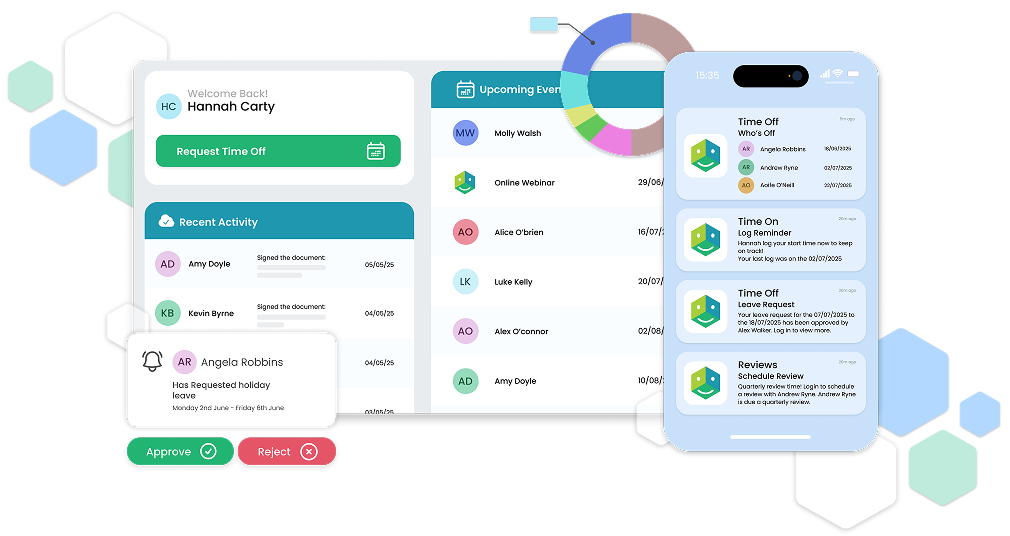According to the most recent Absence Management Survey 2023 from the CIPD, the average number of days lost to sickness per employee is 7.8 days per year.
When last reported, in 2016, the average cost of days off in the public sector amounted to £835 per year. But the bad news is that in the private sector, this cost was just £522. This represents a rise in ‘presenteeism’ where employees feel obliged to work through illness and other conditions. (More on this later.)
But as you know, these figures don’t tell the whole story. There are less tangible, ‘invisible’ costs such as extra workload stress on those covering for missing colleagues or even extra recruiting costs and temporary staff expenses.
Click on the image to see the 2016 CIPD survey
Also telling is the impact of ‘secret carers’. Some workers are obliged to take time off to deal with caring responsibilities for family members with extra needs.
If employees are regularly calling in sick, it can delay projects. Within teams, there is a lack of consistency, leading to low productivity levels. Even those who rarely have sick days can suffer from low motivation and lower productivity if their colleagues are regularly absent.
How to Manage Employee Absence and Sickness Effectively – 12 Steps to Success
1. Cultivate a top-down culture surrounding absence management policy
First of all, it’s vital to make sure there is senior management buy-in to the issues of absence management. There are many realities to deal with, and company culture should reflect this. For example, fostering a non-judgmental environment of openness. For example, it should be ok to share if you are struggling with workload, mental health or stress.
Good workers are valuable. Retaining staff and lessening the impact their jobs have on their wider, personal lives is crucial. Trends indicate that couples are having children later in their lives. Thus, there will be an inevitable ‘sandwiching’ of responsibilities between their offspring and elderly relatives.
The facts are that a ‘four generation’ workforce is inevitable, and a supportive management team will see fewer problems hidden behind recurrent stomach bugs and colds.

2. Produce and put clear written procedures and policies in place for reporting absence
A good absence management policy will list actions and procedures. It should contain information such as who to phone, certification requirements, clarifications of contractual sick pay and statutory sick pay. The policy must be accessible and communicated to all employees.
There are complicated issues to work through. Check regulations around flexible working arrangements. There are both obligations and scope for facilitating flexible working to accommodate your team’s needs. Allow them to juggle their wider responsibilities in life, such as caring for family members or dealing with emergencies.
Be sure that whatever you decide is in line with legislation. Your specific operational needs should be clearly explained and visible. Employees should be aware of exactly what they are entitled to and how they can access the support that’s made available to them.
3. Define roles and accurately record and monitor absence with your HR System
Who is responsible for recording the details of the absence, records and reports statistics? Is anyone responsible for enforcing the absence management policy? Are there absence targets? Is someone flagging flaws in the system? Who provides training to line managers?
Complicated and dated spreadsheets or paper systems are time-consuming and inaccurate, so be sure to use a fast-to-deploy and economical cloud-based HR System.
Be clear on the distinction between HR and departmental function on this subject. Train managers, so that communication is consistent and clear across departments. Managers should be informed on how to handle absenteeism issues.
4. Set absence-level targets
These are not there to pressure staff but to encourage a healthy work-life balance. Targets will help prevent presenteeism and keep absence management top-of-mind in the workforce.
Ensure these targets are kept realistic and improvements are being recognised. A plan should also be set in motion to deal with deviation from ‘acceptable’ levels and cope with the effects of undue absences.

5. Record absences promptly and communicate the data
Keep on top of issues to avoid investigating aged claims. It’s vital to make sure that staff understand the impact of both absenteeism and presenteeism. Get the info out fast and regularly to the manager too, so that it can be acted upon.
Aim to record the number of days missed. HR absence management is easier with software to manage staff sickness. The software will enable you to identify patterns of absenteeism, such as after public holidays, annual leave or particular days of the week. Identifying these trends may be helpful in planning how to address shortages.
Accurate absence management policy reporting gives a clear, factual picture of absence in your organisation. It is useful for making strategic decisions using this data.
6. Fit Notes
Of course, you may require sick notes, but don't overlook the doctor’s order for returning to work. These statements of fitness for work may be issued by medical professionals after longer periods off. They may include recommendations for their recovery. Pay close attention to these and any recommendations that can aid faster recuperation.
Ensure any subsequent equipment or access is provided in line with workplace regulations for employees returning with extra requirements. (E.g., in the U.K. there is the Disability Discrimination Act 1995 to consider.)
7. Conduct return-to-work interviews after absences.
Investigate with care and empathy and handle any contributing factors sensitively. The vast majority of absences are genuine. The style of return-to-work interviews should be supportive and assist employees, rather than being suspicious or hostile.
In cases of long-term absence (4 weeks or more), be sure to keep in regular contact with your employees to check in on their well-being. If appropriate, it can be a good idea to meet with them to get a clear understanding of what and how long their recovery will take.

8. Prevention does not cure
Develop other initiatives in your absence management policy program. Encourage general good attendance in line with modern work-life balance and well-being programs, flexible working conditions, rights and other enhanced working conditions.
Could you offer benefits such as health screening, healthy eating options in canteens, or subsidised fitness subscriptions? If you’re a smaller operation, this doesn’t have to be expensive. You can achieve this through initiatives such as group lunchtime walking schemes or the provision of secure bike parking to encourage cycling to work.
Employee Assistance Programs (EAPs) can aim to help reduce absence by offering support to employees. The goal is to help employees cope with issues in either their work or personal lives. Services such as counselling for stress management, depression, financial worries or colleague relationships can be found.
9. Discourage presenteeism
And remember, achieving 100% attendance is not necessarily desirable if it results in people being at work when they shouldn’t be, due to job insecurity worries. They may end up spreading their condition to others or exacerbating the problem, leading to a longer period of absence or more employees being absent.
Also, be aware that any absence targets and attendance incentives are not encouraging presenteeism. Presenteeism also causes tension between coworkers who fear picking up bugs or having their well-being, time off, or attendance figures affected by sick colleagues coming to work while ill and potentially contagious.
10. Be aware of stress
According to the CIPD, stress and mental health dominate the most common causes of long-term absence. Think of mental well-being in line with physical comfort. For example, unsuitable chairs would contribute to back pain and absence.
Similarly, unrealistic work overload or undue pressure would also result in employee disengagement, unhappiness, absence or loss. In addition to extra obligations and subsequent stress on colleagues, there is the time lost and the cost of recruiting replacements to consider.
A well-being culture with a realistic outlook on workload, adequate training, and employee development can ease insecurities about job security and foster a more productive environment, leading to improved output.

11. Support managers
Many of your most talented managers may have been promoted due to their expertise, but may not be the best natural people managers. Providing training on how they can be effective, constructive team leaders, skilled in how to avert conflict and plan processes and working methods that do not cause undue pressure will pay dividends in efficiency and productivity.
Managers then become ambassadors for the culture of awareness and openness about absence issues, which are integral to the system.
12. Mitigate costs with Income Protection
Many companies can only afford to fund absences for very short periods. Income protection can help you cover the costs of long-term absences by providing a monthly salary and may also include rehabilitation services. A good Income Protection policy will make significant savings against occupational sick pay and other expenses.
SUMMARY
- Absence management policy needs buy-in from the very top, a company-wide culture of absence prevention is essential.
- Don’t be afraid to have open, honest discussions to get to the bottom of issues and have realistic processes in place to move ahead with well-being and ultimately improved productivity in mind.
- Absence management policies and procedures must be clear, readily available, regularly monitored, and effectively communicated. HR Software systems can provide this reporting function.
- Managers should be trained adequately in team management and absence-related issues, plus relevant support programmes should be put in place.
- Costs of employee absence management can be mitigated with insurance.










